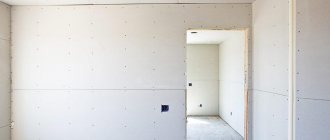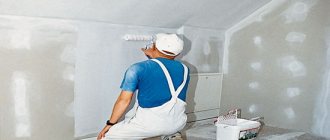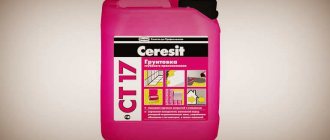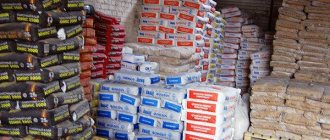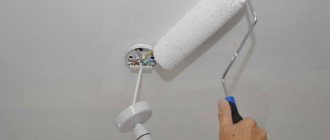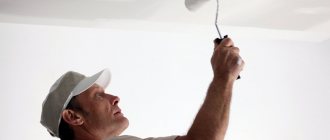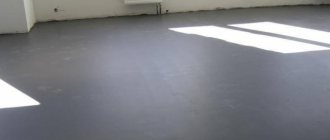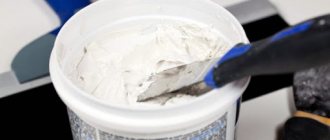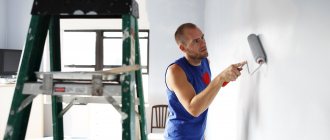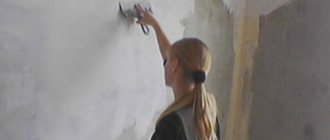Primer for drywall is a special composition that is used to treat the wall before applying the finishing layer. The primed base has better adhesion to the finish and receives additional protection from adverse influences. For the final surface coating, decorative putty, facing tiles and paint are used.
What are primers used for and is it necessary to apply them?
In addition to increasing the adhesion of materials, primer mixtures are intended to protect the coating.
When processing metal structures, they become invulnerable to corrosion. Priming wood allows you to emphasize its natural texture and provide it with fire-resistant characteristics. Distributing the solution over a base made of stone or plasterboard prevents the formation of excess dampness, which provokes mold and mildew.
Drywall primer allows you to reveal the properties of the finish so that it corresponds to the declared quality and special characteristics. When wondering whether it is necessary to prime drywall before puttying, it is enough to evaluate the main functions of such a mixture.
Why prime drywall:
- Drywall primer eliminates minor defects, dents and damage to the base, making it smooth and even.
- The composition gives the coating anti-mold and anti-fungal properties. It also protects the finishing layer from rodents and other pests.
- Priming structures provides additional reinforcement and protection.
Only moisture-resistant material, which is designated in the labeling as GKLV, is not subject to processing. There is no need to prime the surface yet if you plan to apply finishing putty. This layer is elastic and sticky, so it is simply impossible to additionally cover it with a moisture-repellent mixture.
It is important to consider that the primer mixture does not form a film on the wall, limiting air circulation. Its structure resembles a braided mesh.
Before installing the facing tiles, you will need to prime the coating. In addition, it is better to do this in 2 stages. In this case, it is not necessary to level the putty layer much, because decorative material has such properties.
Another argument for priming drywall before caulking is the ease of later disassembly if you want to change the finish.
What affects the setting speed of impregnation?
As mentioned, the polymerization process and uniformity of setting can be affected by changes in room temperature, the presence of drafts or the addition of “acceleration”. So in warm rooms with an air temperature of more than +25°, the impregnation dries quickly enough. Here you should also take into account air humidity, because at levels above 65% this process will last two or even three times longer.
Drying time also depends on what further finishing work the impregnation was carried out before.
- Before gluing the wallpaper, the primer layer must dry thoroughly.
- Before puttingtying or plastering the walls, you should also wait until the primer is completely dry. Otherwise, the solution does not apply well, and after a while it will begin to peel off.
- But for putty and plaster, the waiting time may depend both on environmental conditions and on the composition of the material. On cement-sand plaster, under good conditions, the impregnation will dry in 2-3 hours, and it is not necessary to wait for final setting. On cement-lime it will take 4-6 hours. The primer mixture applies well to the putty and is quickly absorbed. And yet, experts do not advise rushing into further actions: wait a maximum of half a day.
- If you are going to paint a primed surface, then you need to consider the following: Fresh paint will not cause the old coating to peel off if the surface is primed and allowed to dry. You can also paint plastered walls; here, too, several layers of priming will be required. And each subsequent layer is applied only after the previous one has completely dried. The paint adheres well to the primed surface, without streaks. In addition, this reduces the consumption of finishing painting materials.
In any case, before using certain construction and finishing materials, you need to carefully study the technical characteristics and acceptable conditions of use. The answer to the question of how long to wait until the impregnation dries depends on many factors. And we tried to cover most of them.
Reasons for the ambivalent attitude towards gypsum board primer
There are constant discussions among experts about whether it is necessary to prime drywall before puttying. After completing the repair work, many craftsmen do not treat the gypsum board with a primer. However, this leads to gradual destruction of the facing layer and causes a number of problems.
Arguments for
Experts who recommend priming drywall before puttying give the following arguments:
- This mixture efficiently fills cracks and damage, which reduces the consumption of material for subsequent layers.
- During the hardening process, the primer forms a reliable frame on the plasterboard sheet. Such protection copes with almost any vertical loads, which is important when installing porcelain tiles on walls.
- The putty solution cannot provide identical absorbent qualities for the entire substrate, so unevenness will form after the paint is distributed.
- The soil does not interfere with the vapor permeability of the structure, since it does not form a dense film, but a kind of network of threads that does not allow moisture to pass through.
- The primer improves the adhesion of plasterboard with the putty solution.
- Antifungal substances are added to the primer mixture, which allows it to be used for treating rooms with high humidity. It is indispensable for walls in the kitchen or bathroom.
- Acrylic-based products are safe for the environment and the human body.
Arguments against
Opponents of soil point to the following features:
- Before the advent of primer mixtures on sale, plasterboard sheets were treated with paint or covered with wallpaper, and decorative plaster was used. The finishing layer remained on the surface for decades. Conclusion: the soil was developed to earn money, and construction services indicate the importance of this stage in increasing the final cost of the work.
- Drywall sheets have good adhesion to any type of putty. Therefore, priming them is not entirely justified.
- Primers may contain toxic components. They are capable of releasing harmful substances into the environment.
- Putty can act as a primer solution.
- After priming, the coating no longer allows air to pass through, because microholes become clogged.
It is quite difficult to immediately refute the above opinions. In addition, there are a number of situations in which gypsum boards are not primed.
Conclusions regarding waterproofing drywall
Only if a competent approach is applied to the entire process of repair work, from its beginning to the very end, does it become possible to obtain satisfactory results. This rule can be applied to any job. This type of construction work is no exception.
As you can see, there is nothing fundamentally difficult about this work. You just need to have a certain number of working skills and some experience in similar work. If you are confident in your abilities and have reasons to have such confidence, then you are quite capable of doing this work with your own hands. If you do not have the required number of skills and the required amount of experience and, as a result, are not confident in your abilities, then it is better to entrust this work to professionals who know their business perfectly. They will do everything quickly, accurately, spending the optimal amount of resources and time. Regardless of whose hands all the work will be done, if you approach the matter wisely, you can get an excellent result that will delight you with its reliability and beautiful appearance for many years of operation.
How to choose a primer for drywall
Before priming drywall, you need to choose the right composition for this procedure.
Taking into account the type of surface and components of the mixture, the following groups are distinguished:
- Water repellent.
- High penetration compounds.
- Adhesive.
- Heat resistant.
- Antiseptic.
The selection of a suitable option is carried out taking into account the functional purpose of the building and operating conditions.
When preparing and processing gypsum boards, you should take into account the type of finish that will be applied in the following layer:
- If you plan to paint the surface, it is better to use a primer with medium adhesion.
- For thick wallpaper or tiles, a deep penetration mixture will be required.
- In rooms with excessive humidity, a specialized water-repellent solution is used.
If you have not decided on the choice of product, it is recommended to buy a universal primer for gypsum boards.
Priming drywall - what is it for, what does it give
A primer is a special composition that is applied to the prepared surface before painting or other finishing. Priming allows you to more reliably adhere the surface to the coating, level the surface and perform other functions. For example, a primer can protect metal from rust.
Additionally! Unlike the coloring composition, the primer has a small amount of pigment.
The primer can be applied in different ways: with a brush, spatula, spray gun, etc. It all depends on its composition and consistency.
Advantages and disadvantages of processing
Some people believe that priming drywall before puttingtying, applying paint or wallpapering is useless. This is not true: the primer improves adhesion between the surface and the finish, and also protects the walls.
The positive aspects of the procedure include:
- The primer penetrates into the pores of the wall and fills them, which helps save paint and glue.
- The adhesion between the surface and the wallpaper is enhanced, allowing the paint to be distributed more evenly.
- After the primer hardens, the surface becomes more durable. This allows you to hang heavy wallpaper and ceramics on them.
- The composition prevents the formation of mold.
Opponents of priming usually point out that in the past, drywall was painted, plastered and wallpapered on without any problems. Therefore, priming is an easy way for growers to generate additional income.
This is not entirely true, since the functions of the primer are not limited to increasing adhesion. And yet, in some cases it is not recommended to use it:
- In rooms with high humidity, for example, in the bathroom. They use moisture-resistant gypsum board, and the primer will not be able to adhere.
- If you need to achieve perfect evenness of the walls. To do this, use a final putty (finely ground), which can only be applied to a highly absorbent surface. The primer is weakly absorbent, so the surfaces will have to be puttied in several layers - without priming, one layer is enough.
- If within several years it is planned to replace “dry” plaster with “wet” one.
Additionally! Seams and places where screws are attached are always primed.
Types of primer material by composition
The classification of priming products is carried out taking into account the components that are used for their production. The most common are acrylic options.
Acrylic primer
The mixture is made on the basis of acrylic copolymers. The size of the components present in the composition is much smaller than the pore diameter of the surface being treated. This feature ensures soil penetration deep into the wall up to 10 cm.
The substance quickly adheres to materials that allow moisture to pass through, including drywall. Acrylic primer is a universal product that does not have a characteristic odor or toxic substances. This allows it to be used both for external and internal work. Penetration ability increases the wall's protection.
The main properties of acrylic primer include:
- Vapor permeability. This property prevents the surface from clogging, allowing it to “breathe” freely.
- Universal purpose. The primer is suitable for subsequent painting or laying tiles. In addition, the primed base can be covered with any wallpaper.
- Effective filling of pores. The coloring composition is distributed evenly over the coating without changing the tone.
- Saving paint and glue consumption during finishing work.
- Good adhesion to different materials.
Work on waterproofing drywall in a humid environment ↑
Even moisture-resistant drywall needs insulating measures to reduce the negative impact of the humid atmosphere of the room. The main emphasis should be placed on the places where the sheets are attached to the metal guides and to the joining lines of the gypsum boards.
The first problem area that should be given special attention is the line connecting the plasterboard sheet to the floor. For waterproofing to be effective, it is necessary to provide a gap of 5-10mm between the floor and the sheathing.
For information ! In order to “raise a sheet of drywall, it is convenient to use pieces of linoleum, which, when single or folded, gives the required thickness.
Further waterproofing work is carried out in the following sequence:
- All surfaces of the room must be treated with a special primer marked “for absorbent surfaces.”
- Apply waterproofing mastic or water-repellent liquid to the floor surface. In this case, it is worth capturing the bottom of the wall to a height of at least 10-15 cm.
- A sealing tape is applied to the waterproofing layer. After drying, such a compound will become a reliable barrier against water and its evaporation.
Important ! A layer of waterproofing compound must also be applied to the edges of the sealing tape.
Important ! All waterproofing measures must be carried out before finishing work begins.
Thus, the use of drywall in a bathroom is justified if the following rules are met:
- For the walls, a moisture-resistant version of sheet material, marked with the letters GKLV, was used.
- Additional ventilation has been installed with the ability to regulate its operating time.
- Drywall is treated with the required amount of mastic for waterproofing or waterproof solutions.
It is also worth noting that finishing work on top of plasterboard sheets using paint or ceramic tiles increases the insulating characteristics of the material. After all, the more complex the wall structure that results, the less destructive the influence of moisture is.
Types of primers for surface treatment
When wondering how to prime drywall, you need to take into account that, depending on the purpose, primer mixtures are divided into the following types:
- Deep penetration.
- Under the wallpaper.
- Before laying tiles.
- For treatment with water-based paint.
Deep penetration primer for drywall
Finishing with heavy wallpaper or tiles is impossible without first applying a deep penetration mixture. The surface treated with this composition is characterized by improved adhesion. This primer provides an antiseptic quality to the base.
In addition, the solution is resistant to high humidity, does not contain toxic substances and is completely safe for health. The mixture can be used for premises for various purposes, including children's rooms.
Under the wallpaper
To treat the base for subsequent wallpapering, different types of primer are used. If you plan to glue “heavy” rolls, including glass wallpaper and series made of bamboo, textiles or non-woven fabric, you need to use a primer with high adhesive characteristics.
The wallpaper is pasted onto the wall, which is previously puttied. Therefore, it is allowed to use a primer for both clean drywall and putty.
Under tiles
Compositions for laying tiles are necessary for:
- Reducing the level of moisture absorption by drywall.
- Strengthening the fibers of the material.
- Eliminates the problem of mold and mildew.
Once dry, the primer will form a thin film that will prevent moisture from moving from the tile adhesive. An acrylic mixture of deep penetration is recommended for treating the base.
For painting with water-based paint
Before finishing with water-based paint, you need to apply a water-based polymer primer.
Like coloring compounds, such primers:
- Dries quickly.
- They do not have a pungent odor.
Deep penetration solutions are not suitable for painting.
For these purposes, a universal primer is used, which has the following properties:
- Penetrates into the pores of the base material.
- Increases adhesion of paint and substrate.
- Forms a film that reduces the consumption of the color mixture.
- Protects the surface from fungus and mold.
Which is the best primer for gypsum plasterboard under putty?
Under the putty solution, primers for indoor work are used. It is important to choose a deep penetration primer based on acrylic polymers. When interacting with surface voids, the material forms an additional frame, holding a layer of putty on the plasterboard.
Is it necessary to apply primer to the gypsum board before wallpapering?
Despite the fact that plasterboard sheets are a good basis for gluing wallpaper, they require preliminary preparation. The joints of the sheets are first expanded and primed, and the places where the screws are attached are also treated. Then the seams and screws are puttied, and after drying they are sanded.
Next, apply a layer of primer to the entire surface of the wall, leave to dry completely and putty, then sand until smooth. At the very end, the surface is impregnated with a deep penetration primer.
It's easy to see if the drywall needs to be primed before applying putty. The presence of a primer is a requirement of SNiP and GOST. In addition, it is almost impossible to remove wallpaper from drywall that has no primer on it. The wallpaper will come off along with pieces of putty or cardboard, and you will have to spend a lot of effort on finishing the surface.
How to properly use drywall primer
Before treating the base with soil, you need to select the appropriate type of finish, taking into account the purpose of the room. If the soil is produced as a concentrate, it will need to be diluted. By default, water-dispersed mixtures are used, which need to be diluted with liquid.
Acrylic and latex based compositions are suitable for application without dilution. Before applying the primer, you need to remove dust and dirt from the base. Before distribution, the mixture is poured into a container and then applied to the structure using a roller or brush.
Application sequence
It’s easy to apply a primer to gypsum board yourself. This does not require any additional knowledge or skills - even if the layer turns out uneven, it is easy to fix.
To apply the primer you will need various tools:
- The primer itself. You can buy a ready-made mixture or dilute it before work. The quantity is calculated depending on the area of the room. The information required for calculation is indicated on the packaging.
- Brush. It is better to purchase a flywheel and a handbrake - the first is suitable for applying the composition over a large area, the second is for treating narrow places.
- Roller. You will need to choose a roller with medium pile (the pile itself should not fly out) and with a long handle. This will help you quickly process the walls from above.
- A container for priming solution or a flat tray with a ribbed bottom (if a roller is used).
It is also important to have protective equipment - gloves, a mask and goggles. The room should be well ventilated.
Preparatory work
It is impossible to prime the gypsum board immediately after its installation - you must first prepare the surface. There is no need to rush: you won’t be able to fix anything after applying the primer.
Mandatory preparation consists of several steps:
- It is necessary to cut the seams of the sheets along the chamfers. When sheets of drywall are joined, its corners are pressed against each other. These corners need to be cut and deepened so that the composition penetrates inside.
- Tighten all screws so that they do not protrude above the surface.
- Cover the seams with reinforcing mesh.
- Clean the surface thoroughly, removing dust and debris. Once the primer solution has hardened, this will not be possible.
When the wall or ceiling is ready, you can begin to prime it. It is better to do this at above-zero temperatures. Frozen walls will not “accept” the soil, so exterior work should be carried out in the warm season.
How to best apply primers
The soil is distributed onto the surface to be treated using a roller. It is better to use a brush in joints, corners and hard-to-reach places.
How to prime drywall before starting and finishing putty
Before applying putty, it is necessary to prime the entire coating. Before this, the surface is cleaned of dirt and dust. To improve the final result, it is better to re-process after the first layer has dried. Priming is carried out using traditional painting equipment, such as a roller and brush.
Features of the priming process before puttying
Before applying the putty solution, you need to fill the joints with a primer. All seams are treated with reinforcing tape. It is better to cover the fasteners, which use self-tapping screws, with a special putty for seams.
Preparation before wallpapering
Before you hang wallpaper, you need to properly prepare the coating. Therefore, it is worth cleaning the wall from dirt and dust, and then applying a composition with antifungal properties.
When the layer has dried, the seams and screws should be sealed. You also need to clean the putty from sagging and level it.
The next step is to allow the primer to dry. Before wallpapering, the structure should be covered with a thin layer of putty. When applying the putty solution, you need to strengthen the outer corners with metal or plastic corners.
Preparing the surface before gluing tiles
Before laying the facing material, it is necessary to apply a deep penetration primer with antiseptic properties.
Such processing will allow:
- Strengthen the base.
- Improve the adhesion characteristics of materials.
- Reduce water absorption of gypsum boards.
- Apply a protective layer to prevent mold and mildew.
All voids are covered with sickle tape. It is fixed using joint putty. After preparation, the material must be primed again, distributing the mixture evenly over the entire area. There is no need to sand the putty, since the tiles themselves level the surface to be treated.
How to prime plasterboard walls
GKL primer is performed according to the following scheme:
- First, the entire coating is processed.
- Next comes the reinforcement of joints and seams, as well as the installation of corners.
- Then the putty is primed.
The next stage comes down to priming the walls using a brush and roller.
How to apply on the ceiling
The use of gypsum boards for ceilings has been practiced for a long time. After installing the sheets on the ceiling surface, you need to properly process it. It is important to eliminate all defects in the plasterboard, hiding all damage and problem areas. The procedure is carried out by puttying.
To distribute the putty solution over the ceiling, you will need to additionally prime it. This treatment will protect the material from temperature changes and humidity. It improves adhesion and simplifies the distribution of putty.
The base coating can be processed using a roller. It is better to prime corners and awkward areas with a brush. After completing the work and the primer has dried, apply an initial layer of putty, carefully treating the joints and screw heads. Serpyanka is used at the joints.
If the first layer of plaster has dried, you can eliminate obvious defects and apply an additional layer. It is important that it is as even as possible. After all layers have dried, you need to sand the ceiling with sandpaper and proceed to the following procedures.
What can't you do without?
Construction mixtures and tools necessary for processing drywall:
- antibacterial composition;
- sanding mesh and sandpaper;
- paint brushes, rollers and brushes for applying antiseptic and primer;
- spatulas with narrow and wide blades;
- primer;
- gypsum or polymer putty;
- sealant or plaster for sealing joints;
- fiberglass or lavsan mesh tape (serpyanka).
USEFUL INFORMATION: GKLO drywall: it is also fireproof, heat-resistant, fire-resistant
How long does it take for primer to dry on drywall?
The drying time of the primer is determined by several factors.
Among them:
- Environmental parameters such as humidity and temperature. The greatest drying efficiency is observed at +15...+20°C and humidity 60-80%.
- Thickness of the primer layer.
- Type of primer mixture. Formulations with a high content of volatile substances and the presence of solid components dry out faster than water-based products.
Under favorable conditions and room temperature, one layer dries in no more than 2-4 hours. In non-residential buildings, the process time increases to 5-6 hours.
Methods for waterproofing drywall in the bathroom
The second option has higher strength characteristics, since reinforcing fibers, most often cellulose, are added to its composition. Such properties are provided by the significant density of the material, its texture and slightly greater weight.
- Ease of installation;
- Noise-absorbing properties;
- Resistance to combustion and moisture;
- An ideal surface for further finishing work;
- Environmental friendliness;
- Elasticity.
It would be a mistake to hope that natural ventilation installed during the construction of the house will cope properly. After all, its power is usually low due to objective reasons - clogged ventilation ducts, lack of pressure, violation of design conditions during installation. Only a competent approach to all repair activities allows you to obtain a decent quality result.
This rule applies to absolutely all types of work.
- All surfaces of the room must be treated with a special primer marked “for absorbent surfaces.”
- Apply waterproofing mastic or water-repellent liquid to the floor surface. In this case, it is worth capturing the bottom of the wall to a height of at least 10-15 cm.
- A sealing tape is applied to the waterproofing layer. After drying, such a compound will become a reliable barrier against water and its evaporation.
Questions and answers
At different stages of priming drywall, inexperienced craftsmen may encounter difficulties. To avoid them, you should familiarize yourself with the basic questions and answers.
Do I need to prime plasterboard walls before puttying or wallpapering?
The procedure is performed to strengthen the sheets and eliminate the problem of putty peeling. If you do not prime the wallpaper before gluing it, the adhesive mixture will be so absorbed into the drywall that if you want to change the wallpaper, it will be impossible to remove it.
Is it necessary to putty drywall before painting with water-based paint?
If you decide to decorate your room with plasterboard, then you should definitely familiarize yourself with these materials in more detail in order to know what actions can be performed with it and which ones should not be done.
- excellent moisture absorption properties (as mentioned above), therefore, after painting over cardboard, the material may swell;
- the possibility of uneven drying of the product can lead to the appearance of stains on the surface (paint dries differently in different places);
- paint consumption when coating cardboard will increase significantly, and the color will not correspond to what was intended.
In addition, both product options are produced in a moisture-resistant type, which is achieved by using special cardboard with additional processing. If you need to speed up the repair, you can do without completely puttingtying the surface, but you should follow the following recommendations: Store and stack the material only in dry conditions place, as it strongly absorbs moisture. How to putty and prime the ceiling before painting?
This is one of the main reasons for the recommended application of putty.
DIY drywall putty
Before you putty the drywall, prime the surface. Any primer is applied to a dry, clean base. Therefore, we first remove dirt from the surface and remove dust (you can use a vacuum cleaner or a slightly damp cloth). After this, prepare the soil according to the instructions (sometimes you need to dilute it with water, sometimes you just need to stir it), pour it into a container and apply it with a brush or roller.
Once again we go through the seam, applying fresh putty about 0.5 mm thick, take the soaked reinforcing tape and glue it to this compound.
Use a spatula 8 cm wide and press the tape well onto the surface, squeezing out the excess putty from underneath it.
A few words about which putty is best to use for gypsum board. Any one will do - gypsum or polymer based (latex).
Polymer putties are usually finishing - they provide a very thin layer and a smooth surface. There are both starting and finishing plaster ones. Difference in particle size. You can use any, as long as the quality is good. To putty surfaces, you will need a large spatula - with a blade of 40 cm or more and a narrow one - 10 cm.
The first layer is applied with starting putty. It is applied in a layer of about 5 mm (the maximum should be checked in the instructions for the specific putty) and hides all the unevenness. Dilute it with water until it becomes thick sour cream, stir thoroughly so that there are no lumps. Perforated corners are used to design external corners - slopes, protrusions, etc. First, a piece of the required length is cut off. The metal is very thin, it can be cut even with ordinary large scissors, but if you have metal scissors, the work is easier.
Edges are cut at 45C or less, not 90C. So, when puttingtying drywall, the edge will not curl up.
- Environmentally friendly and chemical resistant.
- Moisture resistance and the presence of antiseptic components.
- High level penetration ability.
Apply a layer of finishing mixture to the dried plasterboard wall primer under the putty. Once hardened, the surface should be cleaned
If the finishing will be completed by painting or wallpapering, then another application of primer is performed. When puttingtying drywall, special attention is paid to the joints of two sheets and the recesses left after tightening the screws. This coating will not be able to hide even small flaws, and in some cases will even highlight them
Therefore, proper puttying of drywall is the key to high-quality wall painting. The second method is simpler, and it takes much less time than the first, however, in terms of quality, such a coating will be significantly inferior to the one we did before. You can choose a manufacturer based on ease of use of the solution.
For example, some companies tint mixtures in yellowish or pinkish shades so that it is easy to monitor the uniformity of the layers. Using a clean roller, the soil is distributed evenly over the surface. If a composition with color indexing has been chosen, then it becomes easy to control the areas where the solution is applied during work, as well as the completion of its drying period. The choice of primer material should be approached very carefully.
First of all, you should pay attention to the price. If the price of the mixture is half as much as the price of the same primer from well-known manufacturers, then you should not be happy and choose the cheap one
In a business like construction, the stingy one definitely pays twice.
It is better to choose a proven rather than a cheap manufacturer. Before you start directly priming, you need to choose the right tool with which to carry out the work. Usually this is a soft roller, a brush for hard-to-reach places and a painting tray
When choosing a primer, pay attention to the manufacturer. You should not try to buy soil from an unknown company, even if it is cheaper - the quality of construction work is more important
How to prime drywall
The finishing of drywall is carried out on a previously leveled and primed surface. Not everyone understands the advisability of applying primer. That's why they skip this stage of repair, trying to save a little money on it. And then they wonder why their wallpaper is falling off or their plaster decor is falling off.
There is nothing surprising, because the integrity of the technology was violated during finishing. Many finishing procedures on gypsum plasterboard cannot be done without priming. And those who skip it will inevitably face the problems outlined above.
What is the result of priming plasterboard sheets when finishing them, which primer for plasterboard is most suitable. The answers exist, they are given in the information below.
What is this article about?
How to glue
Before you start gluing onto a gypsum plasterboard surface without putty work, you need to carry out preparations.
If there is old wallpaper on the walls and ceiling, remove it using liquid products, a sponge, or a spatula. After removing the remaining finish, cracks in the old putty may be discovered. It is removed with a scraper.
Where does gluing begin?
If the plasterboard surface is new, carry out the following work:
- It is necessary to inspect the entire surface for flaws - protruding screws, no chamfer at the joint. All defects are eliminated.
- The next step is priming the gypsum board. The mixture coats joints, corners, and fasteners especially well.
- The joints are reinforced with sickle tape or KNAUF paper tape using a mixture of FUGEN, UNIFLOT. The surface is completely dry.
- Afterwards, the applied KNAUF mixture is cleaned with sandpaper to remove small lumps and stripes.
- The fastening points are also covered with Uniflot putty. After drying, clean it.
- All putty joints, corners, and fasteners are covered with a second layer of primer mixture for good adhesion.
- All pencil and marker marks are also covered with a thin layer of putty to avoid the appearance of black spots on the finish coat.
When the surface is prepared, using a laser level or rule, draw an even vertical line on the wall. The length of the strip is transferred to the wallpaper. A section with a margin of 5 cm, that is, if the length of a strip of wallpaper is 2.5 m, then cut off 2.55 m.
12 hours before work, dilute the glue and leave it to dissolve. This is done strictly according to the instructions on the packaging.
Glue is applied to the surface and to the canvas. There are options (non-woven) that do not require you to apply an adhesive composition to the strip, just to the surface.
They begin gluing the strip from top to bottom, gradually smoothing it with a rag from the middle to the side and releasing air, adhering to the mark.
The next strip is glued end-to-end with the first, also smoothing and releasing air.
How to glue in corners
Next, measure the distance from the corner to the last glued strip. The width of the canvas should be equal to this distance plus the approach to the adjacent wall: internal corner 5-15 cm, external corner 2-3 cm.
Often the canvas on the adjacent wall has an uneven border.
Having glued the canvas in the corner, measure the width of the canvas on the adjacent wall and also draw a vertical line along this mark as a guide. Aligning with it, glue the strip with an overlap onto the previous canvas. If the wallpaper has a pattern, select the borders by cutting off the unnecessary strip.
How to stick under the baseboard
There is a wide variety of ceiling skirting boards. All of them are divided into 2 types: soft and hard. Each type has its own principles of pasting.
Flexible and soft skirting boards are glued to the trellises after the surface has dried. To do this, use transparent glue - liquid nails.
The hard ones are fixed to the wall, and then there is pasting, or the finishing coating is already on the surface, but you need to fix the plaster molding to the wall. Then the wallpaper is cut so that 1-2 cm remains under the baseboard. After this, the strip is removed, leaving only drywall. A solid baseboard is fixed to it with gypsum plaster or glue.
If the baseboard is already on the wall, the wallpaper is glued slightly over it. After that, use a spatula to move the plinth a little and insert the canvas. This creates an even angle on the strip, along which the excess is trimmed.
The floor plinth is placed on the cut trellises from the floor. There remains 1-2 cm under the baseboard.
Let's sum it up
In conclusion, I would like to say that proper preparation of walls for future finishing work is almost of paramount importance. Especially when it comes to priming before puttying. Despite the common misconception that if the repair is cosmetic, then it is quite possible to get by with ordinary plaster, paint the walls or hang wallpaper without preliminary preparation and treatment of the surface of the walls - this is just another mistake of those who like to do everything “in a hurry”.
The result of such negligence in relation to work that can be called art - repair - will be plaster falling off in pieces, mold and fungi crawling through the layers of paint and wallpaper, and the wallpaper will gradually slide to the floor or peel off in pieces.
Have you already guessed what the reason is? In the absence of a high-quality primer applied before applying putty.
Agree, it is better to do it once, but with high quality, and spend a couple of hundred rubles more than originally planned, but to do the work on the walls efficiently and for a long time, than in the future to spend money on repeated repairs, done once without proper attitude and responsibility.
Happy priming and strong walls!
